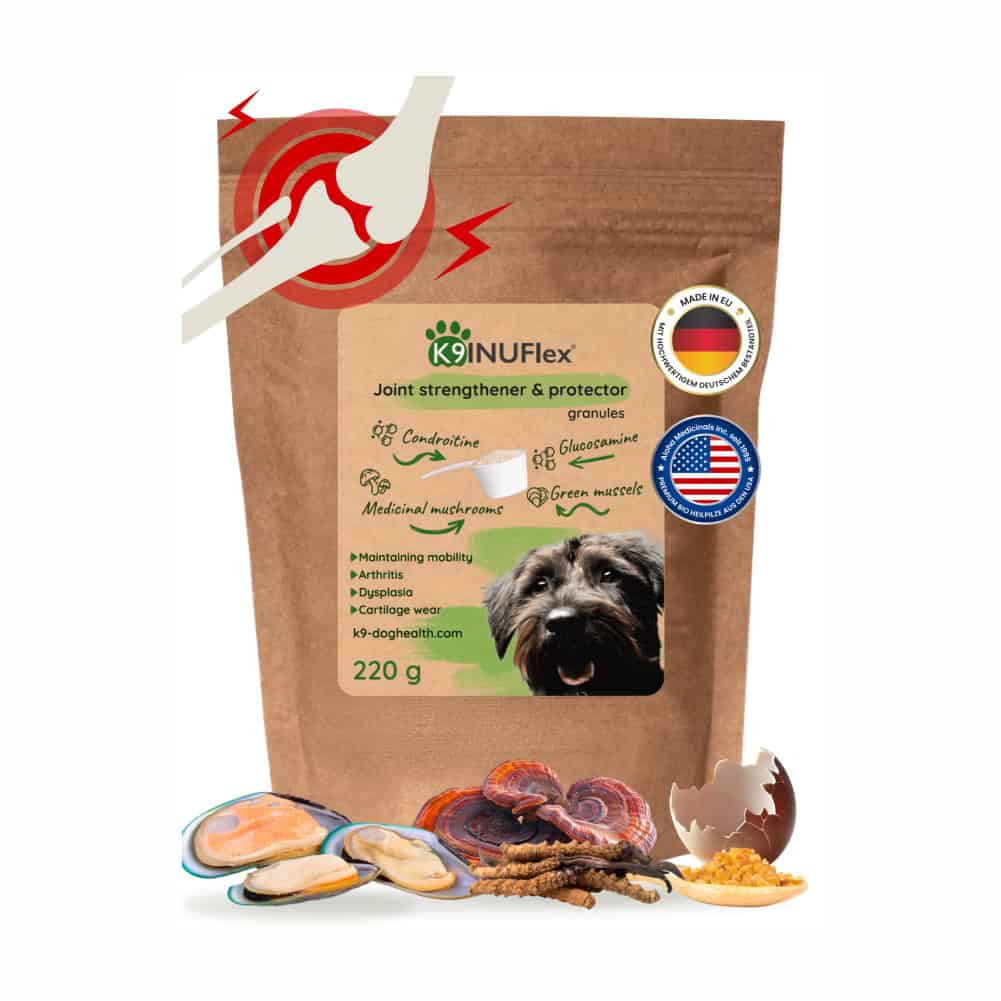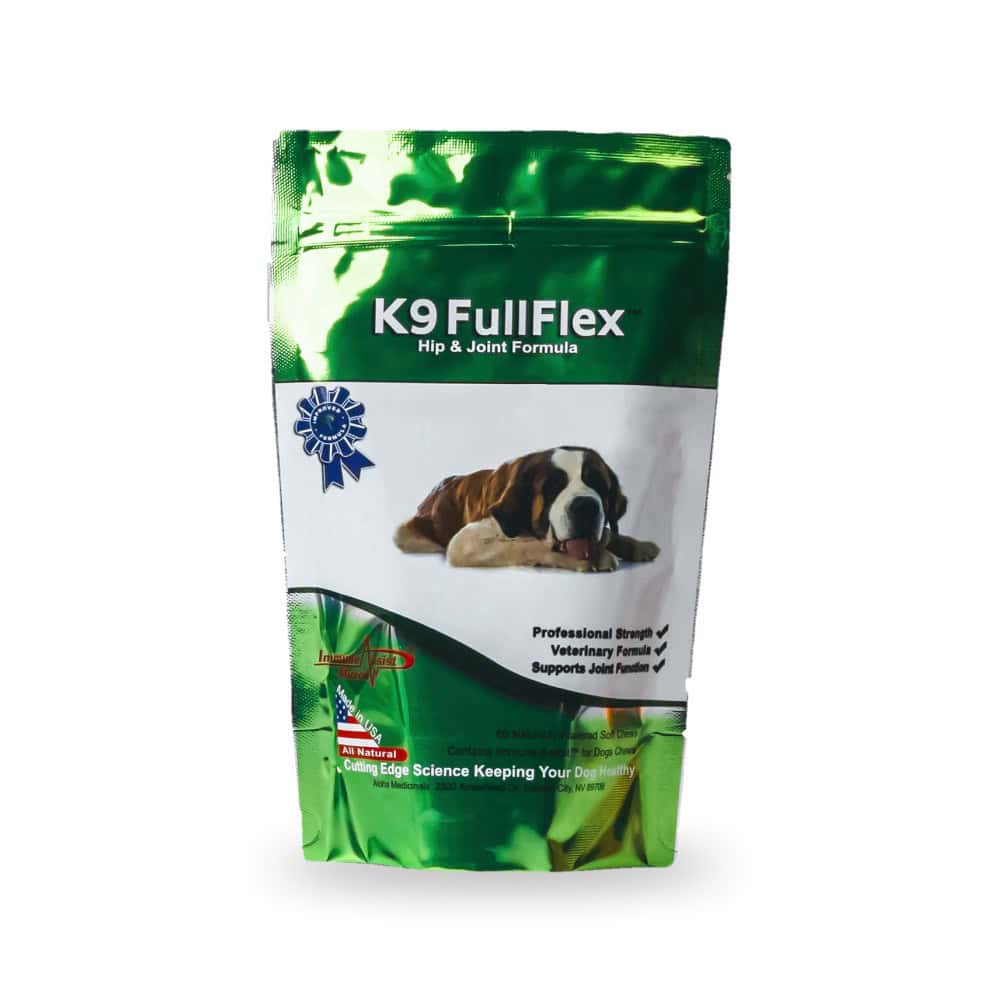Dog food for hip dysplasia – The diet that supports your dog’s joints
If your dog has been diagnosed with hip dysplasia, don’t lose hope – with the right diet, attention, and care, you can do a lot to help them move more freely and feel better again.
Hip dysplasia is a genetically influenced joint malformation, but nutrition plays a major role in how severe the symptoms become. A properly structured diet can slow cartilage wear, reduce inflammation, and support regeneration. The goal isn’t just a longer life – it’s a happier, pain-free, more active one.
What happens in the body during hip dysplasia?

Dog food for hip dysplasia
While hip dysplasia is primarily genetic, poor nutrition can significantly worsen the condition. During growth, it’s crucial to avoid both excessive and insufficient amounts of protein and minerals. Overfeeding can disturb the natural growth balance, leading to loose joints, irregular movement, and discomfort.
Common feeding mistakes for dogs with hip dysplasia
- Too much protein: However, excess protein can cause overly rapid bone growth, which the muscles and joints can’t keep up with. As a result, this imbalance puts stress on the musculoskeletal system and eventually worsens dysplasia.
- Calcium overdose: On the other hand, the “more is better” mindset is dangerous here, because complete dog foods already contain the right calcium-phosphorus ratio. Therefore, adding extra calcium supplements or bone powders is unnecessary – and can even be harmful.
- Too much energy or fat: In addition, excess weight is one of the biggest enemies of a dysplastic dog. Every extra pound increases pressure on the joints and, over time, accelerates joint wear and inflammation.
Principles of a balanced diet for hip dysplasia
The main goal of feeding a dog with hip dysplasia is to reduce joint strain and support cartilage regeneration. That’s why it’s important to provide moderate but high-quality protein, the right calcium-phosphorus ratio, and joint-protective nutrients.
- Choose premium-quality food: Pick a formula designed for large breeds or dogs with joint problems. These diets contain the optimal balance of nutrients, so there’s no need for extra vitamin or mineral supplementation.
- Avoid unnecessary human supplements: If your dog eats complete food, don’t add human vitamins or calcium tablets. These can disrupt mineral balance, which is especially dangerous for dogs with hip dysplasia.
- Keep your dog lean: Maintaining an ideal weight reduces stress on the joints. Feed less, but feed better quality.
What if your dog eats homemade food or follows a BARF diet?
If your dog eats homemade meals or follows a BARF (raw feeding) diet, you’ll need to pay even closer attention to balance. Too much protein, calcium, or an unbalanced vitamin-mineral ratio can make joint problems worse.
- For home-cooked diets: Always consult a veterinary nutritionist to create a precise plan. Most human foods don’t meet a dog’s nutritional needs, and fatty, bony, or seasoned foods can aggravate joint inflammation.
- BARF feeding: Follow the 70–80% meat, 10–15% bone, 10–20% vegetables and supplements ratio. For dysplastic dogs, keeping the calcium-phosphorus ratio around 1.2:1 is essential, along with adding fibrous and micronutrient-rich plant foods.
- Supplements: Whether on a BARF or home diet, it’s worth adding joint-supporting supplements made for dogs such as glucosamine, chondroitin, omega-3 fatty acids, or eggshell membrane (ESM). These help replace joint-protective compounds that may be missing from natural diets.
The most common mistake owners make is overfeeding protein, calcium, or meat out of good intentions. A natural diet can be healthy and effective for dogs with hip dysplasia – but only if it’s precisely balanced and supported with the right supplements.
Dog food for hip dysplasia and natural joint supplements
Natural joint-supporting nutrients can help your dog stay mobile and pain-free. The most effective ones include:
- Glucosamine and chondroitin sulfate: Support cartilage regeneration, improve flexibility, and slow down joint wear.
- Omega-3 fatty acids (EPA, DHA): Natural anti-inflammatories that reduce stiffness and discomfort.
- Green-lipped mussel extract: A natural source of glycosaminoglycans that support cartilage repair and joint lubrication.
- Eggshell membrane (ESM): A natural source of collagen, elastin, and hyaluronic acid that helps maintain joint elasticity and promote cartilage regeneration. Clinical studies show that regular use can reduce stiffness and pain while restoring natural joint structure.
- Turmeric extract: A powerful antioxidant that helps reduce cellular inflammation and oxidative stress.
Home care for dogs with hip dysplasia
Besides proper nutrition, your dog’s environment and exercise routine play a vital role in maintaining comfort and mobility. With a few simple adjustments, you can make a big difference.
- Avoid slippery floors and provide a soft, supportive bed.
- Shorter, more frequent walks (10–15 minutes) are better than one long walk – this reduces joint strain.
- Swimming is one of the best low-impact exercises for dogs with hip dysplasia.
- Avoid sudden jumps, stairs, and intense play sessions.
Common myths about feeding dogs with hip dysplasia
- “Gelatin builds cartilage.” Not exactly. Only collagen precursors are absorbed, and only if enough vitamin C is present.
- “Bones provide all the calcium a dog needs.” Raw bones don’t release minerals efficiently and can’t replace balanced nutrition.
- “Large-breed puppies need more calcium.” The opposite is true – too much calcium can disrupt bone development and increase dysplasia risk.
Preventing hip dysplasia in puppies
Prevention starts early. Puppies should grow at a steady, controlled rate – not too fast – so bones and joints can develop in sync. Balanced energy and protein intake, along with moderate exercise, are key to avoiding severe hip issues later.
Tips for healthy puppy development
- Choose large-breed puppy food specifically formulated for joint health.
- Don’t add extra calcium or vitamins to a complete puppy diet.
- Avoid excessive jumping, climbing stairs, or intense exercise during growth.
Summary – The right diet changes everything
The right dog food for hip dysplasia isn’t just part of daily care, but rather one of the most powerful ways to manage and prevent joint degeneration. Because proper feeding reduces inflammation and supports cartilage health, it can therefore slow down tissue damage and, as a result, extend your dog’s active, happy life. In fact, every single bite truly matters.
Frequently asked questions about dog food for hip dysplasia
❓ How often should I feed a dog with hip dysplasia?
Two smaller meals a day are better for digestion and joint comfort than one large serving. A stable weight is crucial.
❓ What’s the best protein source?
Lean, high-quality meats such as chicken, turkey, fish, or rabbit are ideal. Avoid fatty meats and large quantities of organ meats.
❓ Can I feed homemade meals to a dog with hip dysplasia?
Only if a professional dietitian formulates them. Homemade diets often contain too much protein, calcium, or fat, which can worsen joint issues.
❓ How long can I give glucosamine or green-lipped mussel?
They’re safe for long-term use, but taking a 1–2 month break once a year is recommended. Improvements are usually visible after 3–4 weeks.
If you’d like to do even more for your dog’s joint health, check out our related guides. The Boswellia serrata plant is a powerful natural anti-inflammatory that can help relieve dysplasia symptoms and protect joints, while krill oil provides high-quality omega-3s to support cartilage and skin health. Supporting your dog’s gut microbiome is also key to reducing inflammation and strengthening immunity.
If your dog follows a raw or homemade diet, read our guide on the BARF (raw) feeding method to learn how to maintain the right calcium-phosphorus ratio and avoid nutrient imbalances in dogs with hip dysplasia.
You might also explore topics like dog skin allergies or types of dog cancer to better understand how diet and inflammation are interconnected across many conditions.
Important:
This article on dog food for hip dysplasia is for informational purposes only and does not replace veterinary diagnosis or treatment. Always consult your vet for personalized advice.
References:
- Larsen, J. A., & Farcas, A. K. (2014). Nutrition and orthopedic disease in growing dogs. Journal of Veterinary Internal Medicine, 28(6), 1641–1652.
- Comblain, F., Serisier, S., Barthelemy, N., Balligand, M., Henrotin, Y. (2016). Review of dietary supplements for the management of osteoarthritis in dogs in studies from 2004 to 2014. Journal of Veterinary Pharmacology and Therapeutics, 39(1), 1–15.
- Roush, J. K., Dodd, C. E., Fritsch, D. A., et al. (2010). Multicenter veterinary practice assessment of the effects of omega-3 fatty acids on osteoarthritis in dogs. Journal of the American Veterinary Medical Association, 236(1), 59–66.
- Roush, J. K., Cross, A. R., Renberg, W. C., et al. (2010). Evaluation of the effects of dietary supplementation with fish oil omega-3 fatty acids on weight bearing in dogs with osteoarthritis. Journal of the American Veterinary Medical Association, 236(1), 67–73.
- Fritsch, D. A., Allen, T. A., Dodd, C. E., et al. (2010). A multicenter study of the effect of dietary supplementation with fish oil omega-3 fatty acids on carprofen dosage in dogs with osteoarthritis. Journal of the American Veterinary Medical Association, 236(5), 535–539.
- Ruff, K. J., DeVore, D. P., Leu, M. D., & Robinson, M. A. (2009). Eggshell membrane: A possible new natural therapeutic for joint and connective tissue disorders. Results from two open-label human clinical studies. Clinical Interventions in Aging, 4, 235–240.w





